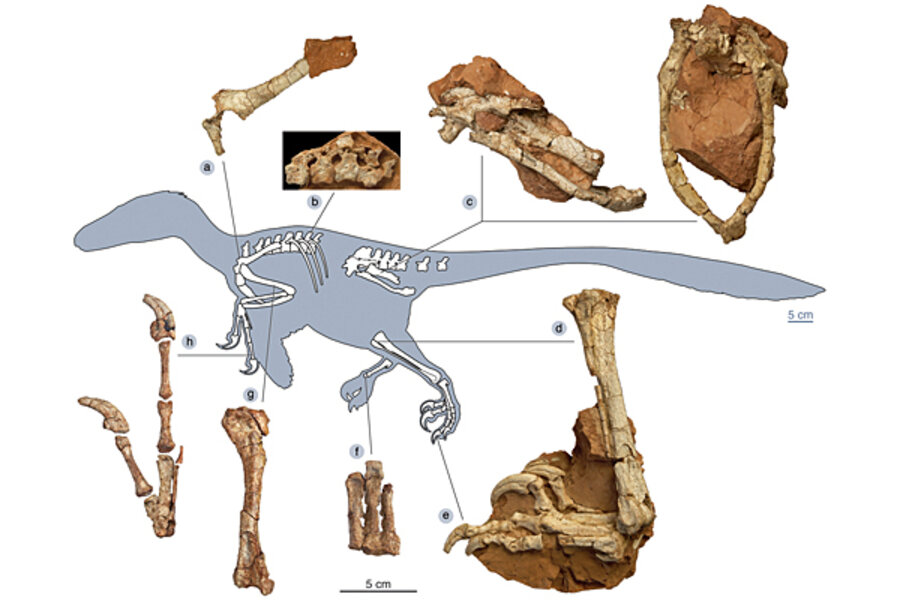'Unusual' dinosaur offers glimpse of evolutionary quirk
Move over Vlad the Impaler; here comes Balaur bondoc.
That's the name scientists have given a new meat-eating dinosaur unearthed in southern Transylvania.
The first formal description of the creature, whose name translates as "stocky dragon," appears in the current issue of the Proceedings of the National Academy of Sciences (PNAS).
The creature is noteworthy for its odd features when compared with many of its contemporaries in other parts of the world, paleontologists say.
The team reporting the results says Balaur also provides fresh evidence for the so-called "island effect," in which geographic isolation spawns unique body forms. In some cases creatures shrink, in others they grow much larger than their continental cousins, and they can evolve to display some truly unique body forms.
Balaur "is really highly specialized and unusual," says Mark Norell, a paleontologist at the American Museum of Natural History in New York and a member of the team reporting the results. The research effort was led by Zoltan Csiki, a paleontologist at the University of Bucharest. Matyas Vremir, a prehistoric tortoise expert at the Transylvania Museum Society in Cluj-napoca, Romania, made the find.
Balaur inhabited Hateg Island, now part of a geological formation in Romania. Some 70 million years ago, however, Hateg Island was a patch of terra firma in the Tethys Sea, forerunner to the modern Mediterranean.
Hans-Deiter Sues, curator of vertebrate paleontology at the Smithsonian Institution's National Museum of Natural History calls Balaur "one of the most exciting discoveries" yet emerging from these ancient island ecosystems that now lay buried within the European continent.
For 100 years, paleontologists have unearthed fossils from this area, Dr. Norell says, including fossils belonging to small plant-eating dinosaurs, mammals, lizards, turtles, and crocodile-like animals.
But not much is known about the top-of-the-food-chain dinosaurs beyond a smattering of fossilized bone fragments from around the continent. The fragments are too nondescript to be helpful in trying to reconstruct the original animal.
"Some people had even argued that the top of the food chain on this island wasn't dinosaurs at all, but crocodillians," Norell says. "Now we've found a carnivore."
If Balaur represents the island effect, it's more for the creature's highly specialized features than a puny or gigantic size, the researchers say.
Balaur stretched some 6 to 7 feet from nose to tail tip, comparable to its nearest contemporary continental relative, Velociraptor. Both shared a common ancestor more than 112 million years ago. The dwarf plant eaters, by contrast, had no close relatives living at the time, suggesting they had been isolated much longer.
Yet Balaur is beefier than its movie-star cousin. Among Balaur's unique features: two sets of readily extended sickle-like claws on each of its hind feet, and hands that host three fingers, only two of which function, instead of all three.
The team also found shoulder bones, vertebrae, pelvis, and other parts of Balaur's skeleton in a mudstone formation near the Romanian down of Sebes, in southern Transylvania.
Dr. Sues notes that Hateg Island was part of an archipelago that stretched from a nascent Iberian peninsula to what is now the Eurasian land mass.
Over the years, researchers have wondered whether islands in the archipelago served as final stops for animals nearing the end of their evolutionary trails, or whether there may have been some continuing contributions to the local fauna from the continent.
With the appearance of Balaur in the fossil record, it would seem the answer may be a bit of both, given the theropod's close relationship with velociraptors uncovered in Mongolia and China, notes Sues in an independent analysis of the find in the same issue of PNAS.
He suggests that during periods when climate conditions led to lower sea levels, the continentals might have island-hopped their way along the archipelago, allowing for some evolutionary changes without losing their clear links to extant relatives on the mainland.





